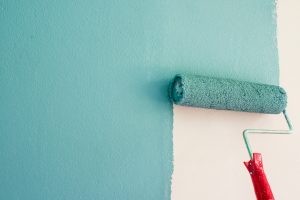
Using Primer vs. Paint and Primer in One
Posted on August 5, 2020
If you’ve ever taken on your own painting jobs, you know it can be a time consuming process. With paint selection to preparation, priming, waiting for coats to dry, applying second coats, and cleanup, there are many steps to consider – and it’s no wonder that people often look for shortcuts to reduce the overall time spent.
One such “shortcut” can be found in paints that boat “pain and primer in one,” also referred to as 2-in-1 paint, self-priming paint, and a host of other similar names. The idea of skipping the priming step may sound appealing…
But does it really work?
First, it’s important to understand the role primer plays in the painting process. You can think of priming as preparing the surface to be painted for the best possible results. Primer helps with adhesion (especially on porous surfaces), covers stains, helps paint apply and dry evenly, and works to seal surfaces for a better looking topcoat.
Paint and primer in one, however, isn’t actually primer. Instead, this clever name describes paint with a greater “build” – meaning that the final layer of dried paint is actually thicker than “normal” paints. While it isn’t actually creating the adhesion that primer does, its final cured state is thicker, providing more coverage and creating some options for more easily painting over existing colors with new hues!
Still… That’s not a clear distinction of which is “better” – because the answer ultimately depends on your usage!
2-in-1, self-priming paint products are a viable option for some internal painting, like redoing bedroom or living room walls that are already painted and in good shape. It will indeed save you the step of applying primer, but it’s also worth considering the increased price of most paints of this kind.
On the other hand, the more traditional method of priming, then painting is followed by most professional painters. Using an actual primer is essential for situations where adhesion may be an issue. This includes unfinished surfaces like wood, masonry, metal, and new drywall, as well as glossy, damaged, or stained surfaces. Similarly, exterior paint that will be exposed to the elements should also be used with primer (and not a 2-in-1 alternative).
So, with all of this in mind, our team of professionals at CertaPro Painters of Metrowest generally recommends using separate paint and primer (that’s what we do), with a handful of limited exceptions.
In most cases, you’ll get better results if you take the time to prime and prep surfaces, and use high quality paint over high quality primer. If you really need to save time, and are simply repainting interior walls that are already in good condition, a self-priming paint is a decent option. In most other situations, however, the more time intensive approach of separate prime and paint is going to yield better results.
If you aren’t sure what approach to take, or would rather leave your next painting project to the pros, don’t hesitate to contact us and our professional painting team at 781-296-6044 for any and all questions!
Looking for more Home Exterior tips? Check out our other home improvement articles!





